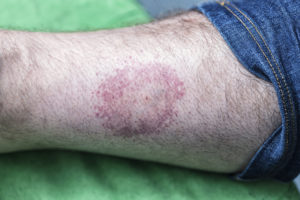Lyme disease, one of the fastest-growing epidemics in the United States, has become so endemic that there is an entire month dedicated to its awareness: May. Each year, Lyme afflicts more than 300,000 people just like you and me. I’ve suffered from Lyme for 20 years and founded Twin Cities Lyme Foundation to help others learn more and take action to avoid and fight this debilitating disease.
According to the Centers for Disease Control (CDC), Lyme disease is more prevalent than breast cancer, colon cancer, HIV and hepatitis C. While these other diseases garner tremendous attention, little is still known about Lyme. May is the perfect time, then, to educate yourself on this disease.
What Is Lyme Disease?
Lyme disease is caused by the bacterium Borrelia burgdorferi, of which there are 300 strains globally — more than 100 of which are found in the U.S. Humans can become infected with Lyme after being bitten by an infected blacklegged tick, also known as a deer tick.
The classic sign of an early, localized infection is an outwardly expanding rash called an erythema migrans — bull’s-eye — rash.
However, there are many atypical rash variations and the majority of patients with Lyme disease have no recollection of a rash. Rashes may feel warm, but are typically painless. Often, in the early stage of this illness, infected individuals will also experience flu-like symptoms, including fever, chills, fatigue and muscle aches. Lyme disease is most easily treated in the very early days of the infection.
If left untreated, infection can spread to joints, the heart and the nervous system.
Taking Precautions
Learning about Lyme disease and taking proper daily precautions are your best defenses for fending off these dangerous bugs.
- Use chemical or natural repellents whenever you are outdoors.
- Avoid particular habitats, such as long grass, where ticks may hide.
- After outside activity, finish your day with a shower using a scrub-type cloth. This helps to sluff off any clinging ticks before they become embedded.
- Some ticks can be as tiny as a speck of pepper, so be diligent when checking yourself or examining others.
- If you suspect you may have Lyme, find a Lyme-literate practitioner in your area, as they are experienced and educated by the International Lyme and Associated Diseases Society (ILADS).
Don’t Give Up Hope
It can be a frustrating journey to find what ails you so that you can begin treatment. I started experiencing Lyme disease symptoms 20 years ago. I didn’t remember being bitten or discovering the “target rash” that is the tell-tale sign of a bite by a diseased tick. I repeatedly tested for Lyme only to receive negative test results.
Blood tests are inaccurate because 50 percent of people who test for Lyme disease test negative. That’s because Lyme can lay dormant in your system, skewing your white blood cell count and producing a negative test result.
If you believe you’ve contracted Lyme, there are many online resources to reference, including the Twin Cities Lyme Foundation’s website. The foundation provides an online assessment for determining your risk level and a guide to Lyme-literate physicians. The foundation also offers grants if you can’t afford to pay for a consultation with a doctor.








